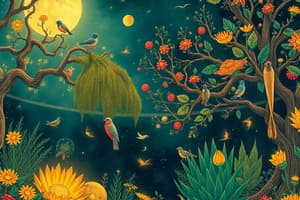Podcast
Questions and Answers
What is the main function of a food chain in an ecosystem?
What is the main function of a food chain in an ecosystem?
- To show the biomass distribution among organisms
- To represent the energy loss at each trophic level
- To model the flow of energy through feeding relationships (correct)
- To describe the behavior of detritivores
Which type of consumer primarily eats only plants?
Which type of consumer primarily eats only plants?
- Omnivore
- Detritivore
- Herbivore (correct)
- Carnivore
What percentage of energy is typically transferred from one trophic level to the next in an energy pyramid?
What percentage of energy is typically transferred from one trophic level to the next in an energy pyramid?
- 20%
- 10% (correct)
- 5%
- 50%
What distinguishes a specialist consumer from a generalist consumer?
What distinguishes a specialist consumer from a generalist consumer?
In the context of food webs, what does a complex network represent?
In the context of food webs, what does a complex network represent?
What is the main characteristic of detritivores in an ecosystem?
What is the main characteristic of detritivores in an ecosystem?
What does an energy pyramid illustrate regarding an ecosystem?
What does an energy pyramid illustrate regarding an ecosystem?
What does biomass refer to in an ecological context?
What does biomass refer to in an ecological context?
Flashcards are hidden until you start studying
Study Notes
Energy Flow Through Ecosystems
- Food chains and webs depict energy transfer within ecosystems.
- A food chain illustrates a linear sequence of feeding relationships, connecting one producer to a chain of consumers.
- Example chain: Grama grass → Desert cottontail → Harris’s hawk.
Types of Consumers
- Consumers categorized by diet include:
- Herbivores: Only eat plants.
- Carnivores: Only eat animals.
- Omnivores: Consume both plants and animals.
- Detritivores: Feed on dead organic matter.
- Decomposers: A specialized group of detritivores, breaking down complex organic matter into simpler compounds.
Feeding Strategies of Consumers
- Specialists: Consumers focusing on a specific organism or a few organisms.
- Generalists: Consumers with a varied diet.
Trophic Levels
- Trophic levels represent nourishment stages in an ecosystem:
- Producers/Autotrophs: Create their own food.
- Primary Consumers: Herbivores feeding on producers.
- Secondary Consumers: Carnivores that eat herbivores.
- Tertiary Consumers: Carnivores that eat secondary consumers.
Food Webs
- Food webs showcase a complex network of feeding relationships, highlighting multiple connections in the ecosystem.
- Emphasizes the intricate nature of energy flow among various organisms.
Energy Distribution in Ecosystems
- Energy pyramids illustrate energy distribution across trophic levels.
- Only 10% of energy is transferred from one trophic level to the next, with significant energy loss at each tier.
Biomass and Organism Distribution
- Biomass refers to the total dry mass of organisms within a specific area, providing insight into the energy availability and ecosystem health.
Studying That Suits You
Use AI to generate personalized quizzes and flashcards to suit your learning preferences.




